
Welcome to Hyperion Records, an independent British classical label devoted to presenting high-quality recordings of music of all styles and from all periods from the twelfth century to the twenty-first.
Hyperion offers both CDs, and downloads in a number of formats. The site is also available in several languages.
Please use the dropdown buttons to set your preferred options, or use the checkbox to accept the defaults.

At this stage, Beethoven’s symphonic plans were diverted by other projects—among them the Missa solemnis—and it was not until 1823 that he set to work in earnest on what had become a single large-scale symphony in D minor. In the summer of that year he told his patron and pupil Archduke Rudolph that he was writing a new symphony for London which he hoped to finish in a fortnight. But as things turned out, the score was not dispatched to London until the following April, by which time plans had already been finalized for the work to be performed in Vienna.
Various accounts of the ninth symphony’s premiere on 7 May 1824 have come down to us. They differ in detail, but they all tell the same story. The deaf composer, oblivious to his surroundings, had his head buried in his own score, and had to be turned to face the audience at the appropriate moments so that he could witness the tumultuous applause. That applause broke out not only at the end of each movement, but occasionally during the music itself—notably in the scherzo, at the point where the leaping theme is so strikingly assigned to the timpani.
The inclusion of voices in a symphonic work was an unprecedented step, and Beethoven expended considerable effort in creating a suitable context for the appearance of Schiller’s paean to joy. To this end, he decided to preface the actual poem with some words of his own, in which the discordant sounds of the finale’s opening fanfare are forcefully rejected, as being inappropriate for a celebration of the brotherhood of man. This was the only occasion on which Beethoven set to music lines he had written himself, and after several rejected attempts, he settled on a solution that plays on the German words ‘Freunde’ (‘friends’) and ‘Freude’ (‘joy’), and provides a natural transition to Schiller’s poem: ‘O Freunde, nicht diese Töne! Sondern laßt uns angenehmere anstimmen und freudenvollere!’ (‘O friends, not these sounds! Let us rather strike up others that are more pleasant and more joyful!’). Each of the reminiscences from the preceding movements which follow on from the terrifying fanfares at the start of the finale is interrupted in turn by an angry burst of instrumental recitative. Only once a snatch of the forthcoming finale theme has been heard does the recitative assume a more positive guise.
The symphony begins mysteriously, with the nebulous sound of a bare fifth, out of which a shattering, jagged fanfare gradually emerges—the most far-flung gesture of its kind Beethoven ever conceived. Twice during the course of the opening movement the material of the opening bars makes a return: once, at the end of the exposition, as if to indicate that a repeat is being made (instead, for the only time in Beethoven’s symphonic opening movements, there is no repeat), and again at the start of the recapitulation. On this last appearance the previously mysterious bars appropriate the dynamic level of the fanfare; and immediately before the fanfare itself emerges, the music alights on a shrieking discord, almost as if in premonition of the famous gesture of horror with which the symphony’s finale is launched. This time the jagged fanfare is harmonized, with the downward leaps of violins and violas countered by an ascent—albeit of more restricted compass—in the basses and cellos. The moment, one of the most astonishing Beethoven ever composed, leaves the music hanging in suspension at precisely the point where we would have expected it to regain its stability.
Uniquely in his symphonies, Beethoven places the scherzo before the slow movement—a sequence that will not be found in any of the great symphonic works of Haydn or Mozart. Beethoven may have opted to reverse the traditional symphonic plan in order to avoid placing the unusually expansive opening movement cheek by jowl with the lengthy Adagio. Not that the scherzo is short: it is, indeed, by a considerable margin the most expansive movement of its kind Beethoven composed. It is prefaced with a rhythmically altered version of the first movement’s jagged fanfare, but the main body of the piece has its origin in a fugue theme Beethoven sketched in 1815, at the time he was working on his D major Cello Sonata Op 102 No 2—a work that ends with an actual fugue. As we have seen, Beethoven had already experimented with tuning his timpani an octave apart in the finale of his eighth symphony, but he puts the idea to even more spectacular use here, with the intervention of the solo timpani near the start of the scherzo calculated to make maximum effect. The much shorter trio section in the major, with its extended passages for the wind instruments on their own, transforms the underlying rhythm from triple metre to duple, though the pulse remains the same.
The slow movement is essentially a series of interwoven variations on two contrasting themes. The first theme is a wonderfully serene hymn-like utterance, with the floating melody of the strings punctuated by wind phrases permeated with the sound of clarinets and horns; while in the more flowing second theme the melodic interest passes to second violins and violas. Much as happens in the fifth symphony, the second theme eventually drops out of sight altogether, and it is left to the first to carry the musical argument.
Like the slow movement, the opening section of the finale is written against the background of a variation form. Following the shrilly discordant fanfares and intervening recitatives, and the reminiscences from the previous movements, the famous theme that will be used to set Schiller’s words ‘Freude, schöner Götterfunken’ is heard unharmonized on the cellos and basses. The initial variation-chain occupies fewer than one hundred bars, before Beethoven provides a lengthy transition to a new theme in the key he would have chosen had he been writing a purely symphonic kind of piece. The function of this new theme is defined by the fact that it never reappears: at this stage Beethoven needs to engender the expectation of a repeat of the exposition, in order to maximize the effect of what transpires instead. What actually ensues is a varied repeat, but one of an unprecedented kind. Having served their purpose, the reminiscences are eliminated; the recitatives are now sung, rather than played, and the orchestral variations are replaced with choral variations. There is an analogy here with first-movement concerto form, where an orchestral opening section is followed by an exposition featuring the soloist—except that here that solo section is vocal, rather than instrumental.
In place of the orchestral exposition’s new subject in the dominant key there is now a dramatic interruption, and immediately following the words ‘Und der Cherub steht vor Gott’ the music plunges into a new key for a passage that confronts the sublime with the sublimely banal, in the guise of a toy march for wind-band, complete with ‘Turkish’ percussion instruments (triangle, cymbals and bass-drum). In Beethoven’s grand sonata design, this marks the start of the development section.
The recapitulation is interrupted by further development, in the shape of a slow movement (‘Seid umschlungen, Millionen!’). Its sustained theme appears at first to be entirely new, but as things turn out it can be combined with the main theme in the form of a double fugue. The words of this section, together with a vastly accelerated form of its theme, will return in the symphony’s exhilarating closing pages. The fugue itself eventually leads to the coda, where the finale’s events thus far are passed in review: the quasi-slow movement is recalled in a breathtaking Adagio excursion into a distant key (‘Alle Menschen werden Brüder, Wo dein sanfter Flügel weilt’); and the Turkish instruments make a return in the jubilant explosion of sound which brings the symphony to its close.
from notes by Misha Donat © 2007
Voyant ses ambitions symphoniques contrariées par d’autres projects (dont la Missa solemnis), Beethoven dut attendre 1823 pour s’attaquer sérieusement à ce qui allait être une unique symphonie à grande échelle, en ré mineur. Cet été-là, il annonça à son mécène et élève l’archiduc Rodolphe qu’il était en train d’écrire une nouvelle symphonie pour Londres, espérant la terminer sous quinze jours. En fin de compte, la partition fut expédiée à Londres seulement en avril de l’année suivante, alors que tout avait déjà été finalisé pour une création à Vienne, le 7 mai 1824.
Divers récits de cet événement nous sont parvenus qui, pour diverger dans les détails, n’en rapportent pas moins tous la même histoire. Le compositeur sourd, inconscient de ce qui l’entourait, avait la tête enfouie dans sa partition et il fallut le tourner face au public pour qu’il pût constater les applaudissements tumultueux qui retentirent à la fin de chaque mouvement mais aussi, parfois, pendant la musique même—notamment dans le scherzo, lorsque le thème bondissant est assigné aux timbales, de manière si saisissante.
L’inclusion de voix dans une œuvre symphonique fut un pas sans précédent et Beethoven s’échina à créer un contexte approprié à l’apparition du dithyrambe de Schiller sur la joie. À cette fin, il décida de le faire précéder de quelques mots de son cru, où les sonorités discordantes de la fanfare liminaire du finale sont rejetées à toute force, inadaptées qu’elles sont à célébrer la fraternité humaine. Ce fut l’unique fois où Beethoven mit en musique des vers de son invention et, après plusieurs tentatives infructueuses, il opta pour un jeu de mots entre «Freunde» et «Freude» («amis» et «joie» en allemand), transition toute trouvée au poème de Schiller: «O Freunde, nicht diese Töne! Sondern laßt uns angenehmere anstimmen und freudenvollere!» («Ô amis, pas ces sons-là! Entonnons-en d’autres, plus agréables et plus remplis de joie!»). L’une après l’autre, les réminiscences des mouvements précédents qui succèdent aux terrifiantes fanfares, au début du finale, sont interrompues par une rageuse explosion de récitatif instrumental, lequel ne revêt un tour plus positif qu’après la survenue d’une bribe du finale à venir.
La symphonie s’ouvre dans le mystère, avec la nébuleuse sonorité d’une quinte dépouillée, d’où émerge peu à peu une fanfare déchiquetée, bouleversante—le geste de ce type le plus ample jamais conçu par Beethoven. Par deux fois dans le mouvement d’ouverture, le matériau des mesures initiales revient: en début d’exposition, comme pour indiquer qu’une reprise est en cours (il n’y en a pourtant aucune, ce qui constitue un cas unique dans les mouvements d’ouverture symphoniques beethovéniens), et, de nouveau, au début de la réexposition. Lors de cette dernière apparition, les mesures auparavant mystérieuses s’approprient le niveau dynamique de la fanfare; et juste avant l’émergence de cette fanfare même, la musique tombe sur une dissonance hurlante, presque prémonitoire du fameux geste d’horreur qui lance le finale. Cette fois, la fanfare déchiquetée est harmonisée, les sauts descendants des violons et des altos étant contrés par une ascension—quoique d’ambitus plus restreint—aux contrebasses et aux violoncelles. Ce moment, l’un des plus surprenants jamais composés par Beethoven, laisse la musique suspendue juste là où l’on se serait attendu à la voir recouvrer sa stabilité.
Par exception, le scherzo précède le mouvement lent—ce qui ne se produit dans aucune grande œuvre symphonique de Haydn ni de Mozart. Peut-être Beethoven a-t-il inversé le plan symphonique traditionnel pour éviter une trop grande proximité entre le mouvement d’ouverture inhabituellement dilaté et le fort long Adagio molto e cantabile. Non que le scherzo soit court: il est, de beaucoup, le plus expansif jamais écrit par le compositeur. Une version rythmiquement altérée de la fanfare déchiquetée du premier mouvement le précède, mais le corps principal de la pièce n’en trouve pas moins sa source ailleurs, dans un thème de fugue esquissé en 1815, à l’époque de la Sonate pour violoncelle en ré majeur, op. 102 no 2—laquelle s’achève sur une véritable fugue. Comme nous l’avons vu, Beethoven avait déjà expérimenté l’usage de timbales accordées à une octave d’écart, dans le finale de sa huitième symphonie, mais ici, il fait de cette idée une utilisation encore plus spectaculaire, les timbales solo intervenant vers le début du scherzo, pour un effet optimum. Bien plus courte, avec des passages prolongés pour les vents seuls, la section en trio, en mode majeur, fait passer le rythme sous-jacent d’un mètre ternaire à un mètre binaire, sans modifier la pulsation.
Le mouvement lent est avant tout une série de variations entremêlées sur deux thèmes contrastés: le premier est une énonciation hymnique merveilleusement sereine où la mélodie flottante des cordes est ponctuée de phrases aux vents imprégnées du son des clarinettes et des cors; le second, davantage fluide, voit l’argument mélodique incomber aux seconds violons et aux altos. À l’image de ce qui se passe dans la cinquième symphonie, ce second thème finit par complètement disparaître, laissant au premier la charge de l’argument musical.
Comme le mouvement lent, la section d’ouverture du finale se fait sur fond de forme variation. Passé les stridentes fanfares discordantes, les récitatifs intermédiaires et les réminiscences des mouvements antérieurs, le fameux thème qui accompagnera les mots de Schiller «Freude, schöner Götterfunken» est donné, non harmonisé, aux violoncelles et aux contrebasses. La chaîne de variations initiale occupe moins de cent mesures, avant une fort longue transition vers un nouveau thème sis dans la tonalité que Beethoven aurait choisie s’il avait écrit une pièce purement symphonique. Ce nouveau thème se justifie par l’unicité de son apparition: à ce moment-là, le compositeur a besoin de susciter l’attente d’une reprise de l’exposition pour optimiser l’effet de ce qui vient à la place. D’où une authentique reprise variée, mais d’un genre inédit: les réminiscences sont éliminées après usage; les récitatifs sont chantés plutôt que joués et les variations orchestrales deviennent chorales. Il existe ici une analogie avec la forme concerto du premier mouvement, où une section d’ouverture orchestrale précède une exposition mettant en scène le soliste—si ce n’est que cette section solo est vocale et non instrumentale.
Une dramatique interruption remplace désormais le nouveau sujet de l’exposition orchestrale dans le ton de dominante et, juste après les mots «Und der Cherub steht vor Gott», la musique plonge dans une nouvelle tonalité pour un passage qui confronte le sublime au sublimement banal, sous les traits d’une marche de petits soldats pour orchestre de cuivres, avec instruments à percussion «turcs» (triangle, cymbales et grosse caisse). Ce qui, dans le grandiose plan beethovénien, marque le début de la section de développement.
La réexposition est interrompue par un nouveau développement, en forme de mouvement lent («Seid umschlungen, Millionen!»), dont le thème tenu paraît d’abord inédit, alors qu’il est combiné en double fugue avec le thème principal. Les paroles de cette section, avec une version largement accélérée de son thème, reviendront dans les exaltantes pages conclusives de la symphonie. La fugue même finit par déboucher sur la coda, où les événements du finale sont passés en revue: le quasi-mouvement lent est rappelé par une époustouflante incursion Adagio dans une tonalité éloignée («Alle Menschen werden Brüder, Wo dein sanfter Flügel weilt»); quant aux instruments turcs, ils reveinnent dans la jubilante explosion sonore qui conclut la symphonie.
extrait des notes rédigées par Misha Donat © 2007
Français: Hypérion
Zu diesem Zeitpunkt konnte sich Beethoven jedoch noch nicht recht auf die Sinfoniepläne konzentrieren, weil er durch andere Projekte—unter ihnen die Missa solemnis—abgelenkt war. Erst 1823 begann er ernsthaft, an dem Sinfonieprojekt zu arbeiten, das mittlerweile aus einer einzigen, groß angelegten Sinfonie in d-Moll bestand. Im Sommer desselben Jahres schrieb Beethoven an seinen Mäzen und Schüler Erzherzog Rudolph, er komponiere gerade eine neue Sinfonie für London, die er in 14 Tagen abzuschließen hoffe. Am Ende wurde die Partitur erst im April des folgenden Jahres nach London geschickt. Da hatte man sich bereits für eine Aufführung in Wien entschieden.
Uns sind diverse Berichte über die Uraufführung der 9. Sinfonie am 7. Mai 1824 überliefert. Sie unterscheiden sich im Einzelnen, vermitteln aber die gleiche Geschichte. Der taube, seine Umgebung nicht wahrnehmende Komponist war in seine eigene Partitur vertieft und musste zu geeigneten Zeitpunkten dem Publikum zugewandt werden, damit er den stürmischen Applaus entgegennehmen konnte. Der Applaus brach nicht nur nach jedem Satz aus, sondern gelegentlich auch während des Musizierens—besonders im Scherzo, an der Stelle, wo das springende Thema so beeindruckend den Pauken überantwortet wird.
Die Einführung von Gesang in ein sinfonisches Werk konnte sich auf keine Vorgänger berufen, und Beethoven gab sich beachtliche Mühe, einen passenden Kontext für den Einsatz der schillerschen Ode an die Freude zu schaffen. Zu diesem Zweck entschied sich der Komponist, dem eigentlichen Gedicht ein paar eigene Worten voranzustellen, in dem die dissonanten Klänge aus der einleitenden Fanfare des Schlusssatzes entschieden als unpassend für eine Huldigung menschlicher Brüderlichkeit zurückgewiesen werden. Das war das einzige Mal, dass Beethoven selber geschriebene Zeilen vertonte. Nach ein paar verworfenen Versuchen fand er eine Lösung, die mit der Ähnlichkeit der Worte „Freunde“ und „Freude“ spielt: „O Freunde, nicht diese Töne! Sondern lasst uns angenehmere anstimmen und freudenvollere!“ Damit schuf Beethoven eine natürliche Überleitung zu Schillers Gedicht. Alle auf die schrecklichen Fanfaren zu Beginn des Schlusssatzes folgenden Erinnerungen an die vorangegangenen Sätze werden jeweils von einem wütend ausbrechenden instrumentalen Rezitativ unterbrochen. Erst nach dem Erklingen eines Ausschnitts aus dem kommenden Freudenthema nimmt das Rezitativ eine positivere Gestalt an.
Die Sinfonie beginnt mysteriös mit dem nebulösen Klang einer leeren Quinte, aus der sich nach und nach eine erschütternde, schroffe Fanfare herausschält—die am weitesten gespannte Geste ihrer Art, die Beethoven jemals geschaffen hat. Zweimal kehrt im Verlauf des ersten Satzes das Material der Anfangstakte wieder: einmal am Ende der Exposition, als würde nun eine Wiederholung einsetzen (stattdessen ist es das einzige Mal in den ersten Sätzen von Beethovens Sinfonien, wo keine Wiederholung erfolgt), und dann wieder zu Beginn der Reprise. Beim letztgenannten Erscheinen haben die ehedem mysteriösen Takte den dynamischen Charakter der Fanfare angenommen. Unmittelbar vor dem Erklingen der eigentlichen Fanfare trifft die Musik auf eine beißende Dissonanz, die fast wie eine Vorahnung der berühmten Horrorgeste wirkt, mit der der letzte Sinfoniesatz beginnt. Diesmal wird die schroffe Fanfare durch abwärts springende Violinen und Bratschen abgefangen, die sich mit den (wenn auch innerhalb eines geringeren Tonumfangs) aufwärts schreitenden Kontrabässen und Violincelli kreuzen. Dieser Moment, einer der erstaunlichsten, den Beethoven jemals komponierte, lässt die Musik genau an der Stelle in der Luft hängen, wo man erwartet hätte, dass sie sich wieder stabilisieren würde.
Wie in keiner anderen seiner Sinfonien platziert Beethoven das Scherzo vor den langsamen Satz—eine Reihenfolge, die auch in keinem großen sinfonischen Werk von Haydn oder Mozart zu finden ist. Vielleicht entschied sich Beethoven für die Umkehrung der traditionellen sinfonischen Anordnung, weil er eine zu enge Nachbarschaft zwischen dem ungewöhnlich langen ersten Satz und dem ausgedehnten Adagio molto e cantabile vermeiden wollte. Nun ist das Scherzo auch nicht gerade kurz: Es ist mit beachtlichem Abstand sogar der längste Satz seiner Art, den Beethoven komponierte. Dem Satz wurde eine rhythmisch abgewandelte Version der schroffen Fanfare aus dem ersten Satz vorangestellt. Der Hauptteil des Stücks hat jedoch seinen Ursprung in einem Fugenthema, das Beethoven 1815 skizzierte, als er an seiner Violoncellosonate in D-Dur op. 102, Nr. 2 arbeitete—ein Werk, dass mit einer richtigen Fuge endet. Wie wir gesehen haben, experimentierte Beethoven schon im Schlusssatz seiner 8. Sinfonie mit einer Stimmung seiner Pauken in Oktaven. Diese Idee setzte er hier noch eindrucksvoller um, indem er zu Beginn des Scherzos auf volle Wirkung abzielend eine Solopauke einführte. Der viel kürzere Trioabschnitt in Dur mit seinen ausgedehnten Passagen für ausschließlich Holzbläser verwandelt den zugrundeliegenden Rhythmus von einem Dreier- zu einem Zweiertakt, auch wenn der Pulse der gleiche bleibt.
Der langsame Satz ist im Wesentlichen eine Reihe verschränkter Variationen über zwei kontrastierende Themen. Das erste Thema ist eine wunderbar klare hymnische Äußerung, in der die schwebende Streichermelodie von Holzbläserphrasen voller eingestreuter Klarinetten- und Hornklänge begleitet wird, während die zweiten Violinen und Violas Verantwortung für das melodische Interesse im fließenderen zweiten Thema tragen. Ähnlich wie in der 5. Sinfonie entzieht sich das zweite Thema schließlich dem Blick, was bedeutet, dass nun das zurückgebliebene erste Thema allein den musikalischen Verlauf steuern muss.
Mit dem langsamen Satz vergleichbar wurde auch der einleitende Abschnitt des Schlusssatzes auf dem Hintergrund einer Variationsform komponiert. Nach den schrillen dissonanten Fanfaren, einschreitenden Rezitativen und den Erinnerungen an die vorangegangenen Sätze vernimmt man in den Violoncelli und Kontrabässen einstimmig das berühmte, zur Vertonung von Schillers Worten „Freude, schöner Götterfunken“ herangezogene Thema. Die anfängliche Variationsreihe beansprucht weniger als 100 Takte. Dann liefert Beethoven eine ausgedehnte Überleitung zu einem neuen Thema in der Tonart, die er selbst gewählt hätte, wäre das ein rein sinfonisches Werk gewesen. Dieses ohnehin nie wiederkehrende Thema erfüllt nur eine Funktion: An dieser Stelle muss Beethoven die Erwartung auf eine Wiederholung der Exposition schüren, um die Wirkung von dem zu erhöhen, was tatsächlich als Nächstes passiert. Zwar folgt eine Wiederholung. Die ist aber abgewandelt und von beispielloser Art: Die Erinnerungen werden eliminiert, da sie ihren Zweck erfüllt haben, die Rezitative erklingen jetzt gesungen anstatt gespielt und der Chor übernimmt die ehemaligen Orchestervariationen. Es gibt zudem eine Analogie zur Form eines ersten Konzertsatzes—wo auf eine Orchestereinleitung eine den Solisten vorstellende Exposition folgt—nur ist dieser Soloabschnitt hier für Gesang anstatt für ein Instrument.
Anstelle des in der Dominante stehenden neuen Orchesterexpositionsthemas folgt jetzt eine dramatische Unterbrechung. Sofort nach den Worten „Und der Cherub steht vor Gott“ stürzt die Musik in eine neue Tonart für eine Passage, die in Form eines Spielzeugmarsches für Blaskapelle einschließlich „türkischer“ Schlaginstrumente (Triangel, Becken und großer Trommel) Außerordentliches mit außerordentlich Banalem konfrontiert. In Beethovens großartigem Sonatenplan signalisiert der Marsch den Anfang des Durchführungsabschnitts.
Die Reprise wird durch eine weitere, wie ein langsamer Satz wirkende Durchführung unterbrochen („Seid umschlungen, Millionen!“). Ihr ausgedehntes Thema scheint zuerst völlig neu zu sein. Später erkennt man aber, dass es sich mit dem Hauptthema zu einer Doppelfuge kombinieren lässt. Die Worte dieses Abschnitts sowie eine enorm beschleunigte Form seines Themas werden auf den aufregenden letzten Momenten der Sinfonie wiederkehren. Die Fuge selbst führt schließlich zur Koda, wo die bisherigen Ereignisse des Schlusssatzes Revue passieren: Der langsame Pseudosatz wird noch einmal in einem atemberaubenden Adagio-Ausflug zu einer entfernen Tonart („Alle Menschen werden Brüder, Wo dein sanfter Flügel weilt“) in Erinnerung gerufen. Auch die türkischen Instrumente treten wieder auf, nämlich in der jubilierenden Klangexplosion, die die Sinfonie beschließt.
aus dem Begleittext von Misha Donat © 2007
Deutsch: Elke Hockings
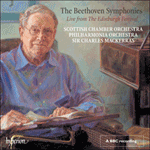 Beethoven: Symphonies Beethoven: Symphonies‘Hyperion's set is that early evening Beethoven cycle caught in recordings of remarkable intimacy and focus … it is a set I would happily put int ... ‘So magnificently exhilharating an account’ (BBC Music Magazine)» More |
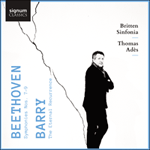 Beethoven: Symphonies Nos 7, 8 & 9 Beethoven: Symphonies Nos 7, 8 & 9Beethoven's final three symphonies—Nos 7 & 8 composed as a pair in 1812, the monumental No 9 following twelve years later and concluding with the famous 'Ode to Joy'. Beethoven's original audience was decidedly ambivalent regarding his use of huma ...» More |
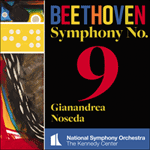 Beethoven: Symphony No 9 Beethoven: Symphony No 9Beethoven's Symphony No 9 is a landmark in the history of music, changing the concept of what a symphony could be. The use of solo singers and a chorus in the final movement was revolutionary, and the emotional journey to a glorious vision of a wo ...» More |
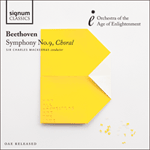 Beethoven: Symphony No 9 Beethoven: Symphony No 9Beethoven’s euphoric Symphony No 9, recorded live at the 1994 Edinburgh International Festival, is performed by the Orchestra of the Age of Enlightenment under Sir Charles Mackerras.» More |
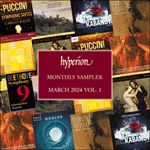 Hyperion sampler - March 2024 Vol. 1 Hyperion sampler - March 2024 Vol. 1 |

